Mechanical Properties and Microstructure of Fibre-Reinforced Clay Blended with By-Product Cementitious Materials
Abstract
1. Introduction
2. Scope of Study
3. Materials and Method
4. Experimental Program
4.1. Mix Compositions and Sample Preparation
4.2. Laboratory Testing
4.2.1. Unconfined Compression Test
4.2.2. Swell Test
4.3. Scanning Electron Microscope (SEM)
5. Results and Discussion
5.1. Unconfined Compressive Strength (UCS) of Samples Cured under Normal Temperature
Effect of Elevated Temperature on UCS
5.2. Linear Expansion
5.3. Scanning Electron Microscopy (SEM) of Treated Soils
5.4. Geological Engineering Significance
6. Conclusions
- An increase in polypropylene and glass fibre contents caused an increase in UCS but brought on the reduction of linear expansion at fibre content up to 0.8% for cement-clay mixture reinforced with 5%PC. The use of 0.4–0.8% polypropylene and glass fibre contents in reinforcing cement-clay mixture at 5% cement content caused an increase in UCS values above minimum UCS target value according to ASTM 4609 after 7 and 14 days curing at 20 to 50 °C temperature.
- At reduced cement content of 2%, cement-clay mixtures blended with lime and GGBS required 14 days curing period under 20 °C to achieve UCS value greater than minimum UCS target value according to ASTM 4609; however, at elevated curing temperature of 30 to 50 °C, higher UCS values were obtained after 7 days’ curing period. For the samples cured under elevated curing temperature, the observed increase in unconfined compressive strength upon reduction in cement content implies that less PC should be needed to stabilise clay soils under tropical than under temperate conditions.
- At reduced cement content of 2%PC and inclusion of 3% micro silica, the microstructure of the fibre-reinforced clay showed a denser matrix with closely parked particles at 0.8% fibre content compared to a microstructure with pore and hollow cavity at 0% fibre content for 2%PC + 3%MS mixture.
- At elevated curing temperature up to 50 °C, the addition of polypropylene and glass fibres in cement-clay mixtures blended with GGBS and micro silica caused an increase in UCS even at reduced cement content of 2%.
- The increase in UCS is due to the development of a cementitious compound called the calcium silicate hydrate (CSH gel) during the hydration of cement and subsequent increases in the bonding between particles, filling of pores and formation of a more closely packed soils. Therefore, this new clean production of fibre-reinforced cement-clay mixture blended with industrial by-product materials can be applied in a wide range of soil reinforcements.
Compliance with Ethical Standards
Author Contributions
Funding
Conflicts of Interest
References
- Modarres, A.; Nosoudy, Y.M. Clay Stabilization Using Coal Waste and Lime—Technical and Environmental Impacts. Appl. Clay Sci. 2015, 116–117, 281–288. [Google Scholar] [CrossRef]
- Abbey, S.J.; Ngambi, S.; Coakley, E. Effect of Cement and By-Product Material Inclusion on Plasticity of Deep Mixing Improved Soils. Int. J. Civ. Eng. Technol. 2016, 7, 265–274. [Google Scholar]
- Farouk, A.; Shahien, M.M. Ground Improvement Using Soil-Cement Columns: Experimental Investigation. Alexandria Eng. J. 2013, 52, 733–740. [Google Scholar] [CrossRef]
- Abbey, S.J.; Eyo, E.U.; Ng’ambi, S. Swell and Microstructural Characteristics of High-Plasticity Clay Blended with Cement. Bull. Eng. Geol. Environ. 2019. [Google Scholar] [CrossRef]
- Nidzam, R.M.; Kinuthia, J.M. Sustainable Soil Stabilisation with Blastfurnace Slag–A Review. Proc. Inst. Civ. Eng.-Constr. Mater. 2010, 163, 157–165. [Google Scholar] [CrossRef]
- Higgins, D. Soil Stabilisation with Ground Granulated Blastfurnace Slag; UK Cementitious Slag Makers Association (CSMA): London, UK, 2005. [Google Scholar]
- Eyo, E.U.; Ngambi, S.; Abbey, S.J. Investigative Study of Behaviour of Treated Expansive Soil Using Empirical Correlations. In International Foundation Congress and Equipment Expo 5–10 March; American Society of Civil Engineers (ASCE): Orlando, FL, USA, 2018; pp. 373–384. [Google Scholar]
- Abbey, S.J.; Ng’ambi, S.; Ganjian, E. Development of Strength Models for Prediction of Unconfined Compressive Strength of Cement/by-Product Material Improved Soils. Geotech. Test. J. 2017, 40, 928–935. [Google Scholar] [CrossRef]
- Eyo, E.U.; Ngambi, S.; Abbey, S.J. Investigative Modelling of Behaviour of Expansive Soils Improved Using Soil Mixing Technique. Int. J. Appl. Eng. Res. 2017, 12, 3828–3836. [Google Scholar]
- Eyo, E.U.; Ngambi, S.; Abbey, S.J. Performance of Clay Stabilized by Cementitious Materials and Inclusion of Zeolite / Alkaline Metals-Based Additive. Transp. Geotech. 2020, 23. [Google Scholar] [CrossRef]
- Abbey, S.J.; Ngambi, S.; Olubanwo, A.O. Effect of Overlap Distance and Chord Angle on Performance of Overlapping Soil-Cement Columns. Int. J. Civ. Eng. Technol. 2017, 8, 627–637. [Google Scholar]
- Wild, S. Effects of Ground Granulated Blast Furnace Slag (GGBS) on the Strength and Swelling Properties of Lime-Stabilized Kaolinite in the Presence of Sulphates. Clay Miner. 1996, 31, 423–433. [Google Scholar] [CrossRef]
- Cokca, E.; Yazici, V.; Ozaydin, V. Stabilization of Expansive Clays Using Granulated Blast Furnace Slag (GBFS) and GBFS-Cement. Geotech. Geol. Eng. 2009, 27, 489–499. [Google Scholar] [CrossRef]
- James, R.; Kamruzzaman, A.H.M.; Haque, A.; Wilkinson, A. Behaviour of Lime–Slag-Treated Clay. Proc. Inst. Civ. Eng.-Gr. Improv. 2008, 161, 207–216. [Google Scholar] [CrossRef]
- Azzam, W.R. Utilization of Polymer Stabilization for Improvement of Clay Microstructures. Appl. Clay Sci. 2014, 93–94, 94–101. [Google Scholar] [CrossRef]
- Soltani, A.; Taheri, A.; Khatibi, M.; Estabragh, A.R. Swelling Potential of a Stabilized Expansive Soil: A Comparative Experimental Study. Geotech. Geol. Eng. 2017, 35, 1717–1744. [Google Scholar] [CrossRef]
- Haase, H.; Schanz, T. Compressibility and Saturated Hydraulic Permeability of Clay-Polymer Composites —Experimental and Theoretical Analysis. Appl. Clay Sci. 2016, 130, 62–75. [Google Scholar] [CrossRef]
- Correia, A.A.S.; Venda Oliveira, P.J.; Custódio, D.G. Effect of Polypropylene Fibres on the Compressive and Tensile Strength of a Soft Soil, Artificially Stabilised with Binders. Geotext. Geomembr. 2015, 43, 97–106. [Google Scholar] [CrossRef]
- Olgun, M. Effects of Polypropylene Fiber Inclusion on the Strength and Volume Change Characteristics of Cement-Fly Ash Stabilized Clay Soil. Geosynth. Int. 2013, 20, 263–275. [Google Scholar] [CrossRef]
- Tang, C.-S.; Shi, B.; Cui, Y.-J.; Liu, C.; Gu, K. Desiccation Cracking Behavior of Polypropylene Fiber–Reinforced Clayey Soil. Can. Geotech. J. 2012, 49, 1088–1101. [Google Scholar] [CrossRef]
- Puppala, A.J.; Musenda, C. Effects of Fiber Reinforcement on Strength and Volume Change in Expansive Soils. Transp. Res. Rec. J. Transp. Res. Board 2007, 1736, 134–140. [Google Scholar] [CrossRef]
- Abdi, M.R.; Parsapajouh, A.; Arjomand, M.A. Effects of Random Fiber Inclusion on Consolidation, Hydraulic Conductivity, Swelling, Shrinkage Limit and Desiccation Cracking of Clays. Int. J. Civ. Eng. 2008, 6, 284–292. [Google Scholar]
- Ikizler, S.B.; Aytekin, M.; Nas, E. Laboratory Study of Expanded Polystyrene (EPS) Geofoam Used with Expansive Soils. Geotext. Geomembr. 2008, 26, 189–195. [Google Scholar] [CrossRef]
- Al-Akhras, N.M.; Attom, M.F.; Al-Akhras, K.M.; Malkawi, A.I.H. Influence of Fibers on Swelling Properties of Clayey Soil. Geosynth. Int. 2008, 15, 304–309. [Google Scholar] [CrossRef]
- Punthutaecha, K.; Puppala, A.J.; Vanapalli, S.K.; Inyang, H. Volume Change Behaviors of Expansive Soils Stabilized with Recycled Ashes and Fibers. J. Mater. Civ. Eng. 2006, 18, 616–617. [Google Scholar] [CrossRef]
- Wang, Y.; Cui, Y.J.; Tang, A.M.; Tang, C.S.; Benahmed, N. Effects of Aggregate Size on Water Retention Capacity and Microstructure of Lime-Treated Silty Soil. Géotechnique Lett. 2015, 5, 269–274. [Google Scholar] [CrossRef]
- Tang, C.; Shi, B.; Gao, W.; Chen, F.; Cai, Y. Strength and Mechanical Behavior of Short Polypropylene Fiber Reinforced and Cement Stabilized Clayey Soil. Geotext. Geomembr. 2007, 25, 194–202. [Google Scholar] [CrossRef]
- Zaimoglu, A.S.; Yetimoglu, T. Strength Behavior of Fine Grained Soil Reinforced with Randomly Distributed Polypropylene Fibers. Geotech. Geol. Eng. 2012, 30, 197–203. [Google Scholar] [CrossRef]
- Consoli, N.C.; Arcari Bassani, M.A.; Festugato, L. Effect of Fiber-Reinforcement on the Strength of Cemented Soils. Geotext. Geomembr. 2010, 28, 344–351. [Google Scholar] [CrossRef]
- Soltani, A.; Deng, A.; Taheri, A. Swell–Compression Characteristics of a Fiber–Reinforced Expansive Soil. Geotext. Geomembr. 2018, 46, 183–189. [Google Scholar] [CrossRef]
- Viswanadham, B.V.S.; Phanikumar, B.R.; Mukherjee, R.V. Swelling Behaviour of a Geofiber-Reinforced Expansive Soil. Geotext. Geomembr. 2009, 27, 73–76. [Google Scholar] [CrossRef]
- Syed, M.; Guharay, A. Stabilization of Expansive Soil Reinforced with Polypropylene and Glass Fiber in Cement and Alkali Activated Binder. In Advancements in Unsaturated Soil Mechanics; Hoyos, L., Shehata, H., Eds.; Springer International Publishing: Cham, Switzerland, 2020; pp. 41–55. [Google Scholar]
- Ateş, A. Mechanical Properties of Sandy Soils Reinforced with Cement and Randomly Distributed Glass Fibers (GRC). Compos. Part B Eng. 2016, 96, 295–304. [Google Scholar] [CrossRef]
- Ahmad, F.; Mujah, D.; Hazarika, H.; Safari, A. Assessing the Potential Reuse of Recycled Glass Fibre in Problematic Soil Applications. J. Clean. Prod. 2012, 35, 102–107. [Google Scholar] [CrossRef]
- Ali, G.; Saeed, K.; Parham, R. Stabilization of Silty Sand Soils with Lime and Micro silica Admixture in Presence of Sulfates. In Proceedings of the 14th Pan-American Conference on Soil Mechanics and Geotechnical Engineering, Toronto, ON, Canada, 2–6 October 2011. [Google Scholar]
- Al-azzawi, A.A.; Daud, K.A.; Abdul Sattar, M.A. Effect of Micro silica Addition on the Behavior of Silty-Clayey Soils. J. Eng. Dev. 2012, 16, 92–105. [Google Scholar]
- Long, G.; Li, L.; Li, W.; Ma, K.; Dong, W.; Bai, C.; Zhou, J.L. Enhanced Mechanical Properties and Durability of Coal Gangue Reinforced Cement-Soil Mixture for Foundation Treatments. J. Clean. Prod. 2019, 231, 468–482. [Google Scholar] [CrossRef]
- Kalkan, E. Influence of Micro silica on the Desiccation Cracks of Compacted Clayey Soils. Appl. Clay Sci. 2009, 43, 296–302. [Google Scholar] [CrossRef]
- Goodarzi, A.R.; Akbari, H.R.; Salimi, M. Enhanced Stabilization of Highly Expansive Clays by Mixing Cement and Micro silica. Appl. Clay Sci. 2016, 132–133, 675–684. [Google Scholar] [CrossRef]
- Alrubaye, A.J.; Hasan, M.; Fattah, M.Y. Stabilization of Soft Kaolin Clay with Micro silica and Lime. Int. J. Geotech. Eng. 2017, 11, 90–96. [Google Scholar] [CrossRef]
- ACI, C. 230. State-of-the-Art Report on Soil-Cement. Mater. J. 1990, 87, 395–417. [Google Scholar]
- Jha, A.K.; Sivapullaiah, P.V. Mechanism of Improvement in the Strength and Volume Change Behavior of Lime Stabilized Soil. Eng. Geol. 2015, 198, 53–64. [Google Scholar] [CrossRef]
- Jamshowang, P.; Nuansrithong, N.; Voottipruex, P.; Songpiriyakij, S. Laboratory Investigations on the Swelling Behavior of Composite Expansive Clays Stabilized with Shallow and Deep Clay-Cement Mixing Methods. Appl. Clay Sci. 2017, 148, 83–94. [Google Scholar] [CrossRef]
- Chore, H.S.; Vaidya, M.K. Strength Characterization of Fiber Reinforced Cement–Fly Ash Mixes. Int. J. Geosynth. Gr. Eng. 2015, 1, 1–8. [Google Scholar] [CrossRef]
- Cheng, Q.; Zhang, J.; Zhou, N.; Guo, Y.; Pan, S. Experimental Study on Unconfined Compression Strength of Polypropylene Fiber Reinforced Composite Cemented Clay. Crystals 2020, 10, 247. [Google Scholar] [CrossRef]
- Mohammed, Y.F.; Aamal, A.A.; Mather, M.J. Characteristics of Clays Stabilized with Lime-Silica Fume Mix. Ital. J. Geosci. 2015, 134, 104–113. [Google Scholar] [CrossRef]
- Clare, K.E.; Pollard, A.E. The Effect of Curing Temperature on the Compressive Strenght Of Soil-Cement Mixtures. Géotechnique 1954, 4, 97–106. [Google Scholar] [CrossRef]
- Abd El-Aziz, M.; Abo-Hashema, M.; El-Shourbagy, M. “The effect of Lime Silica Fume Stabilizer on Engineering Properties of Clay Subgrade”. In Proceedings of the Fourth Mansoura International Engineering Conference (4th IEC), Faculty of Engineering, Mansoura, Egypt, 1–4 April 2004. [Google Scholar]
- Saghiri, M.A.; Orangi, J.; Asatourian, A.; Gutmann, J.L.; Garcia-Godoy, F.; Lotfi, M.; Sheibani, N. Calcium silicate-based cements and functional impacts of various constituents. Dent. Mater. J. 2017, 36, 8–18. [Google Scholar] [CrossRef] [PubMed]
- Al-Soudany, K. Remediation of Clayey Soil Using Silica Fume. In Proceedings of the 3rd International Conference on Buildings, Construction and Environmental Engineering, BCEE3-2017, Sharm el-Shiekh, Egypt, 23–25 October 2017. [Google Scholar] [CrossRef]
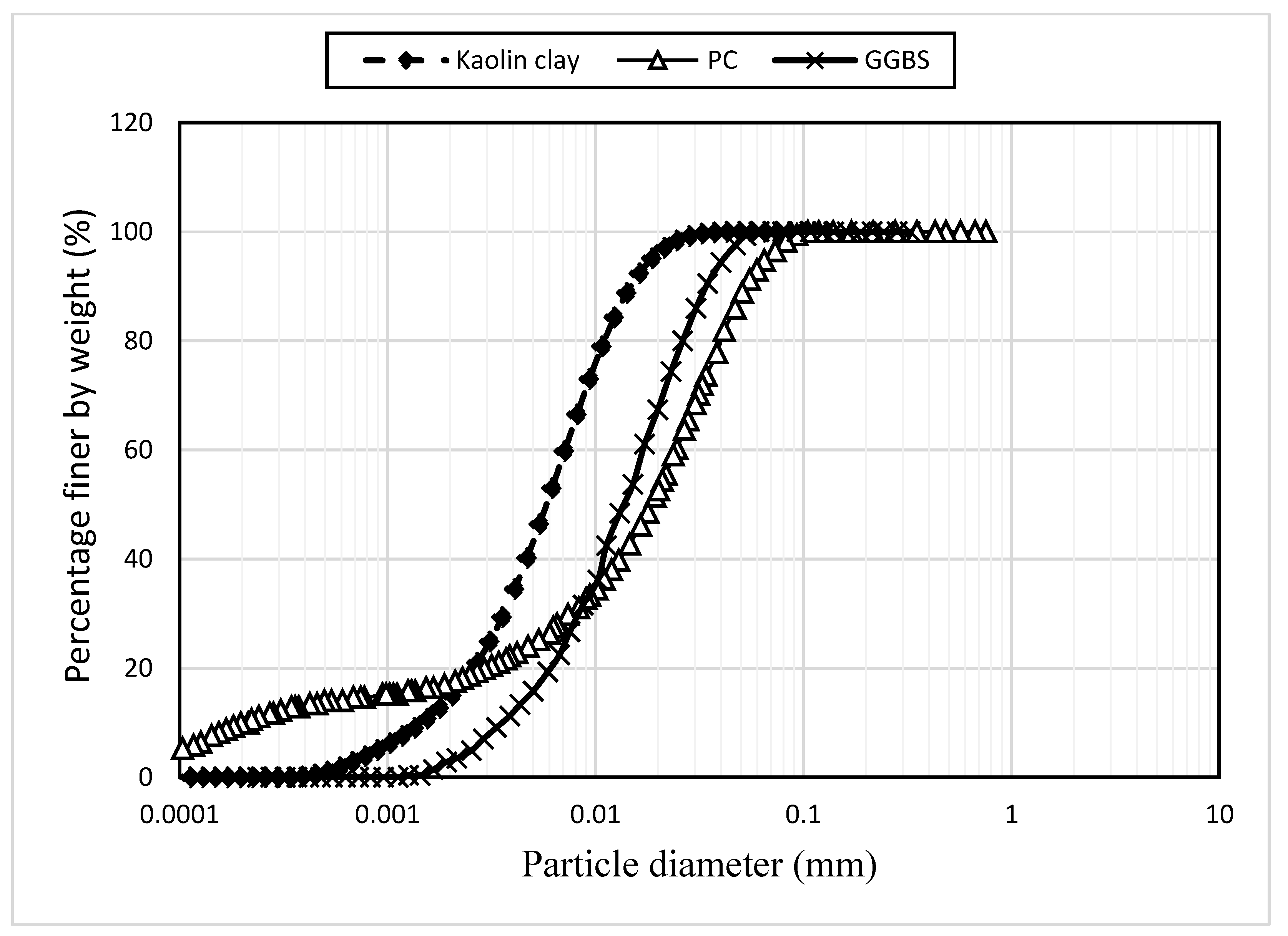
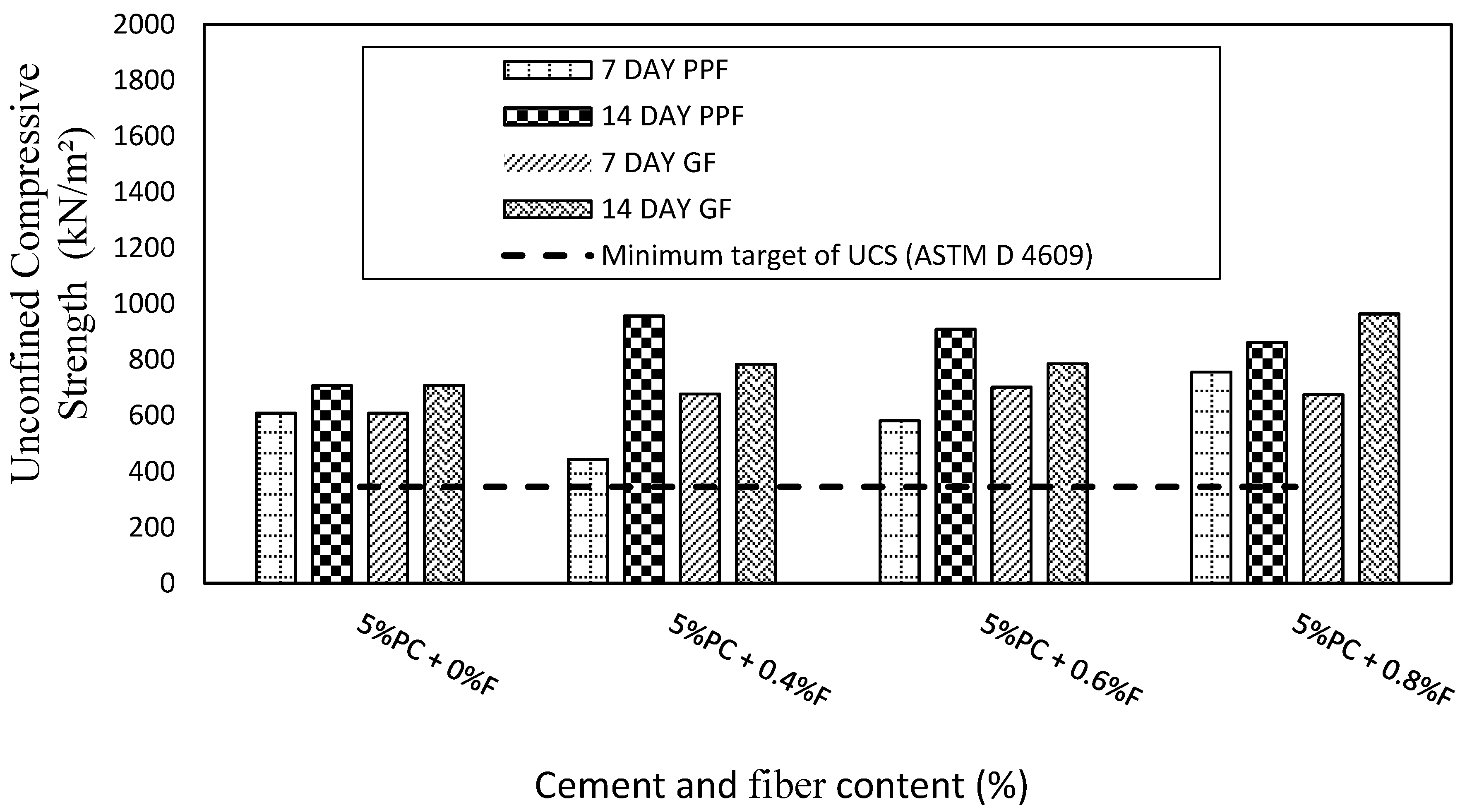
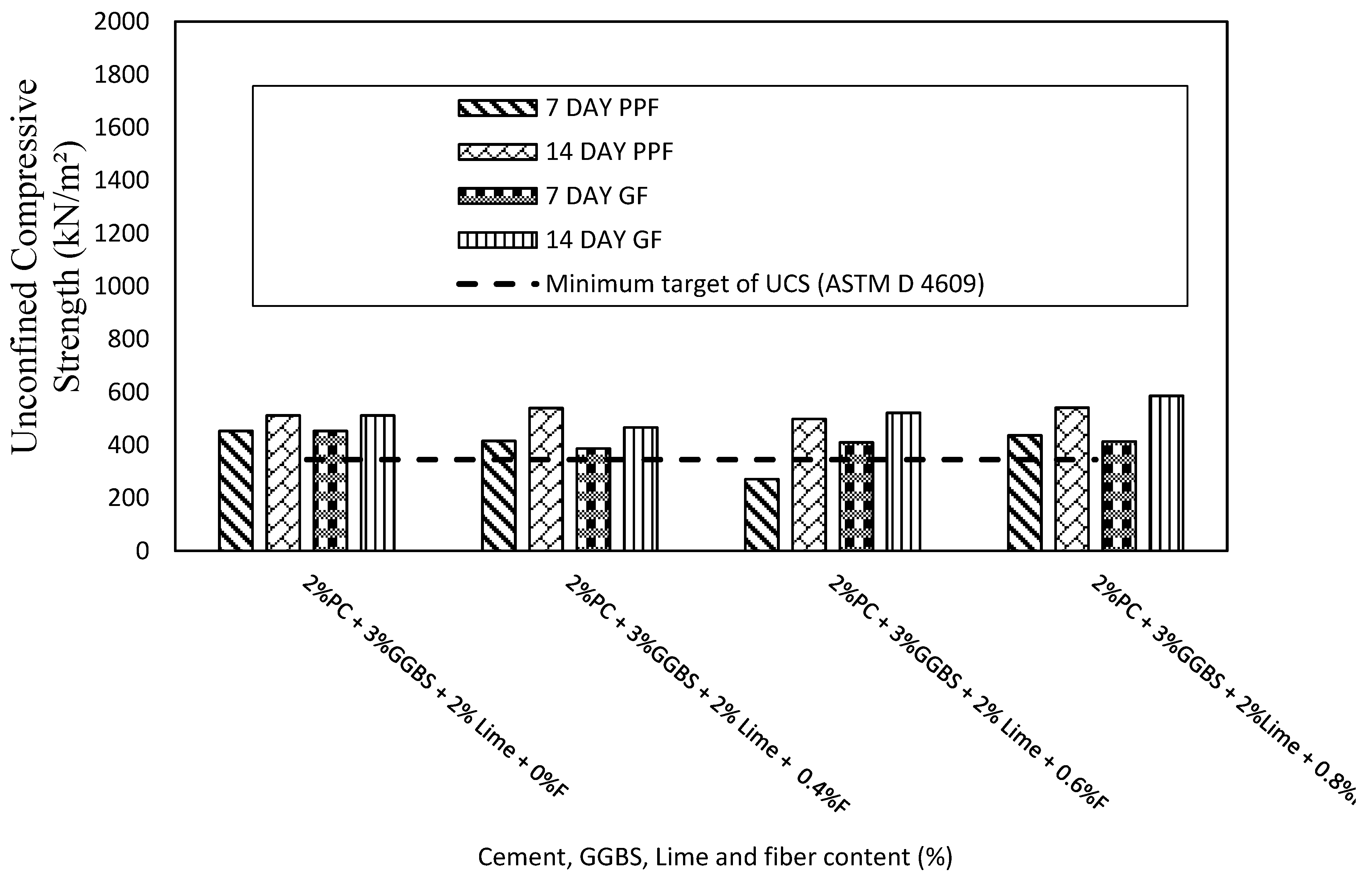
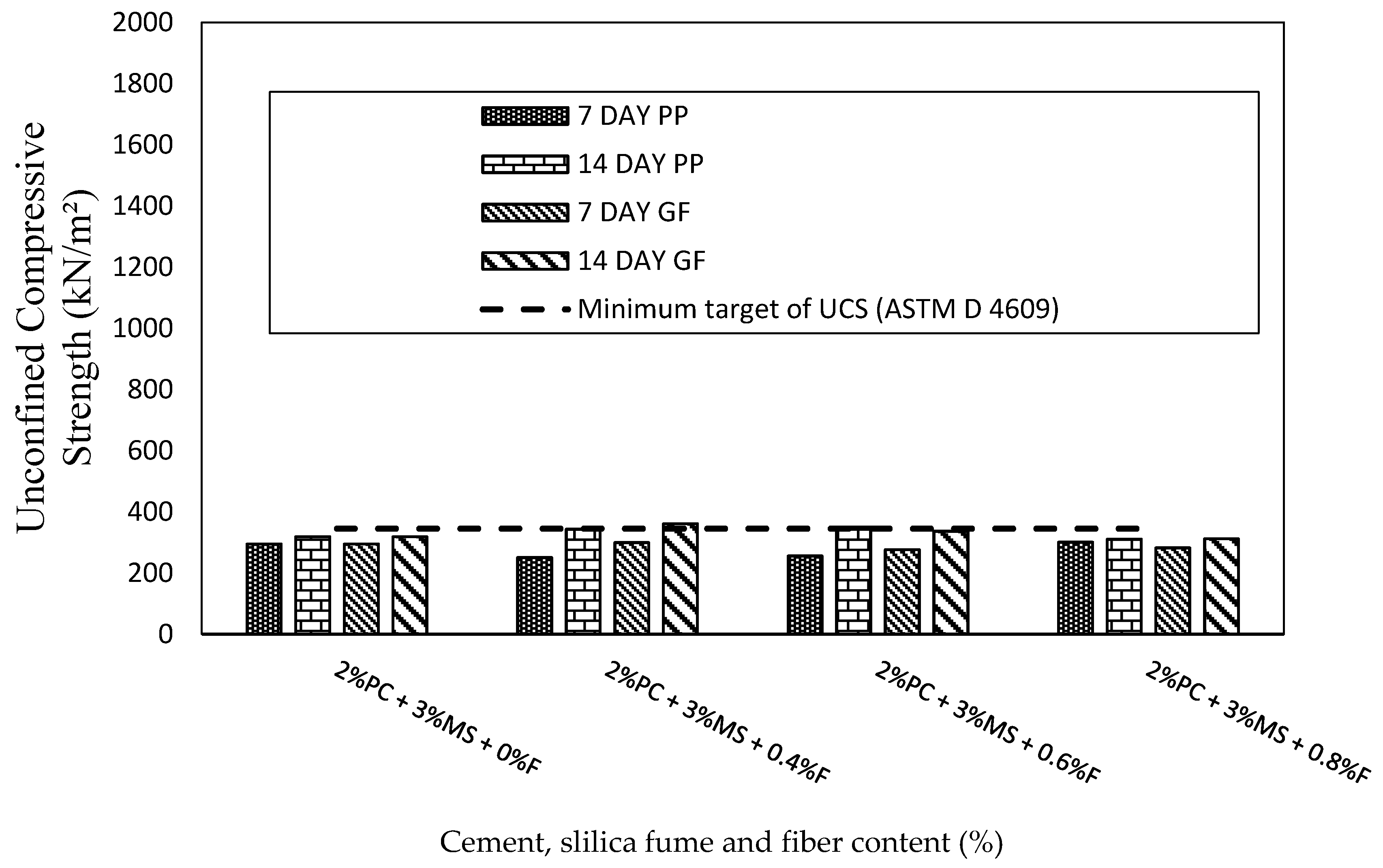
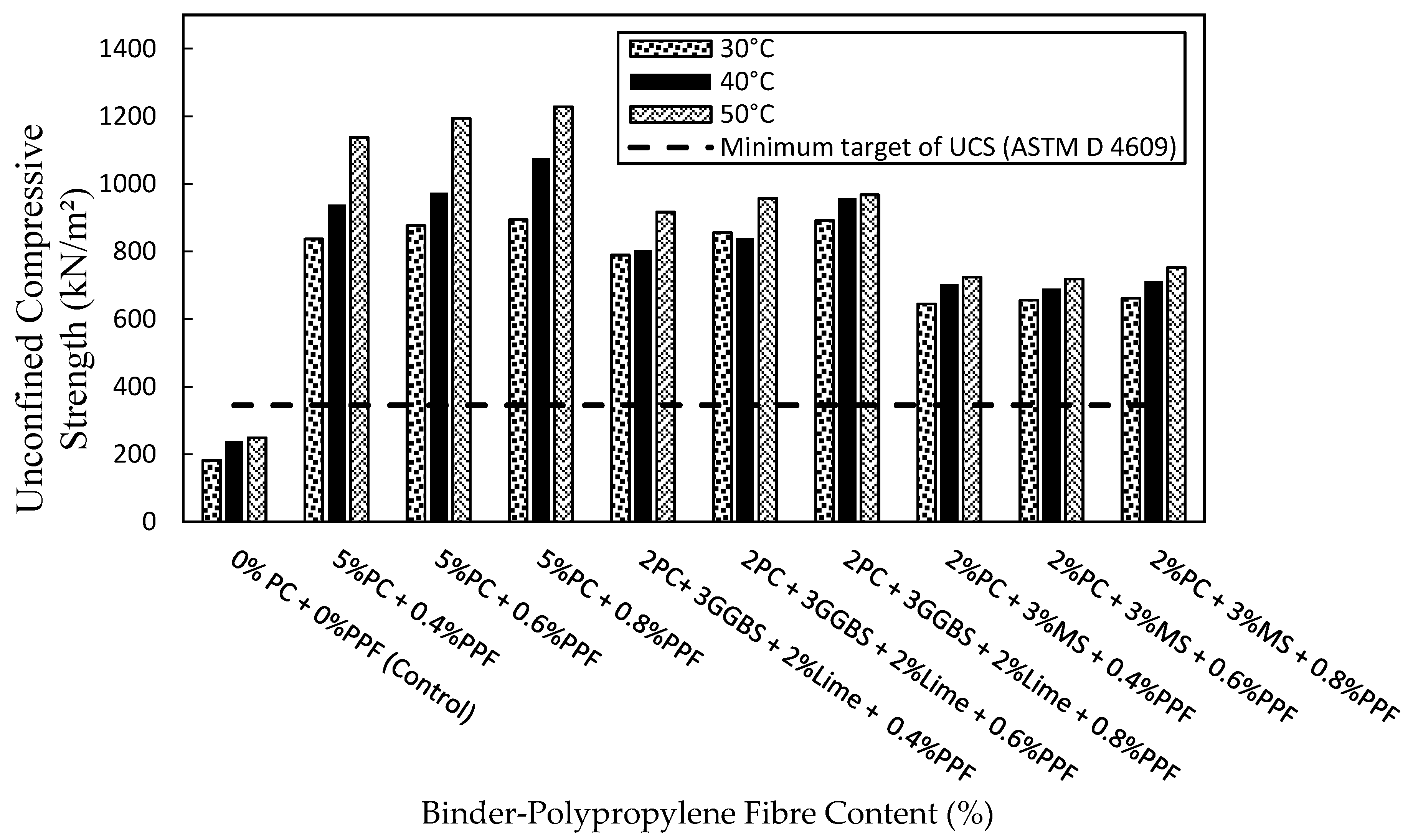
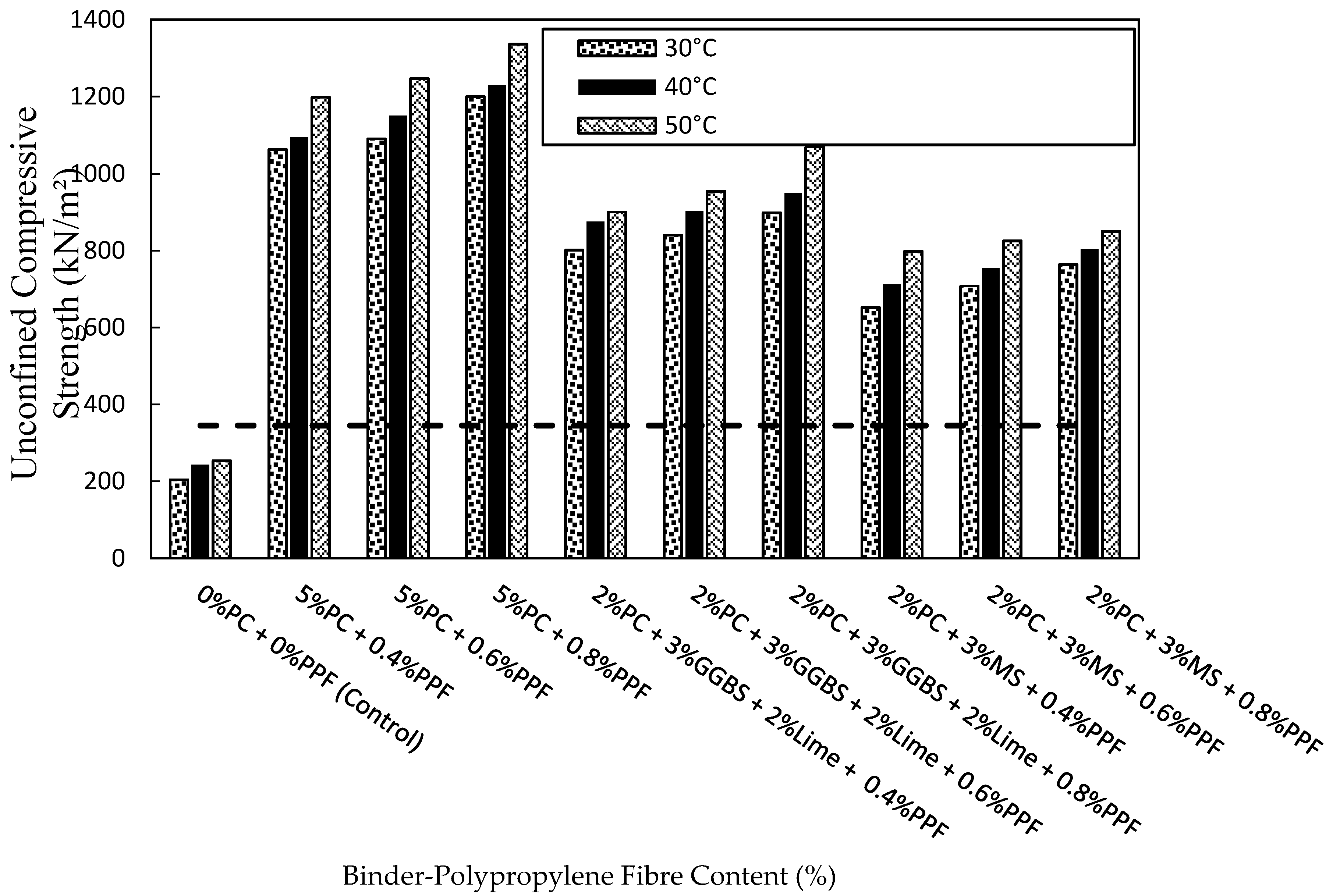

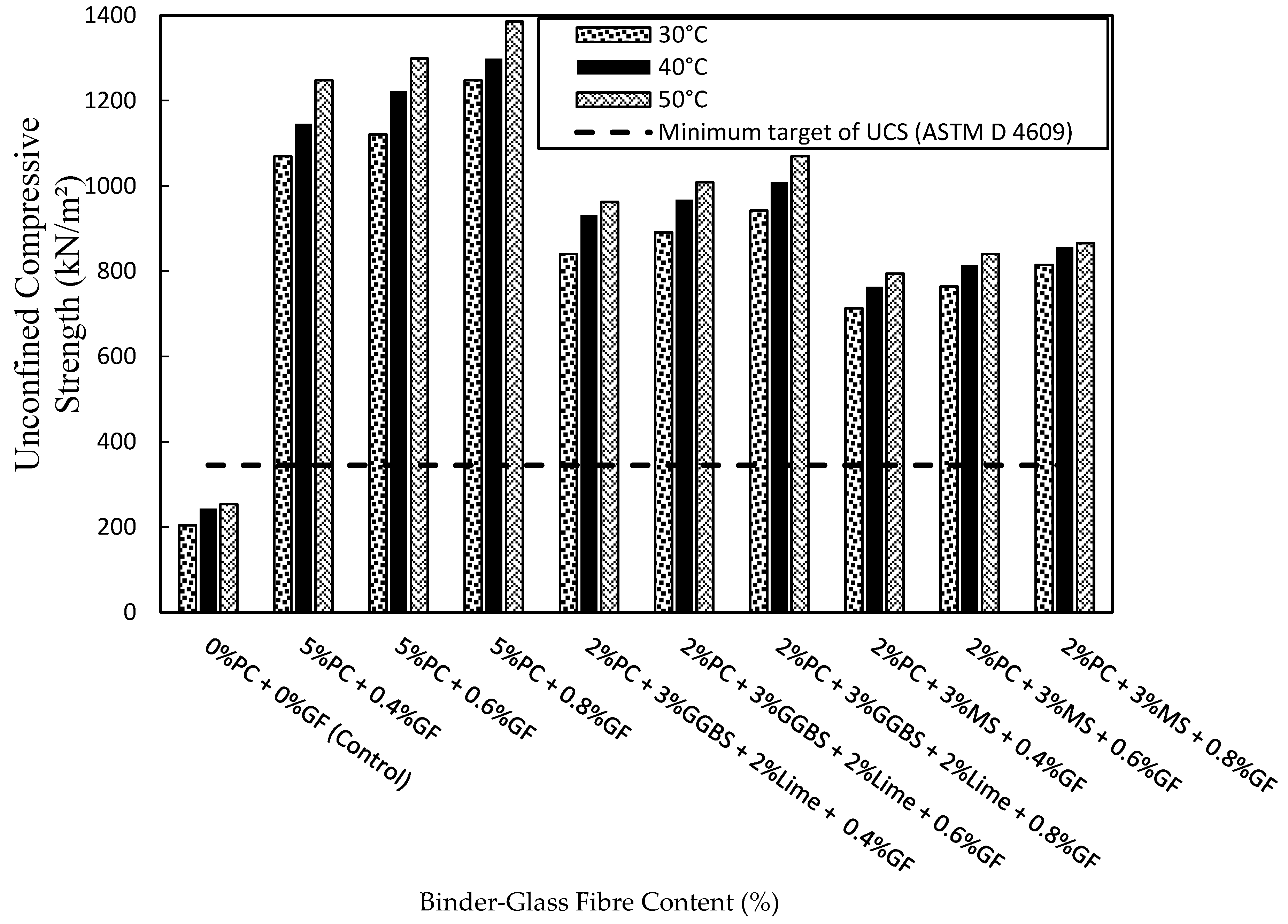
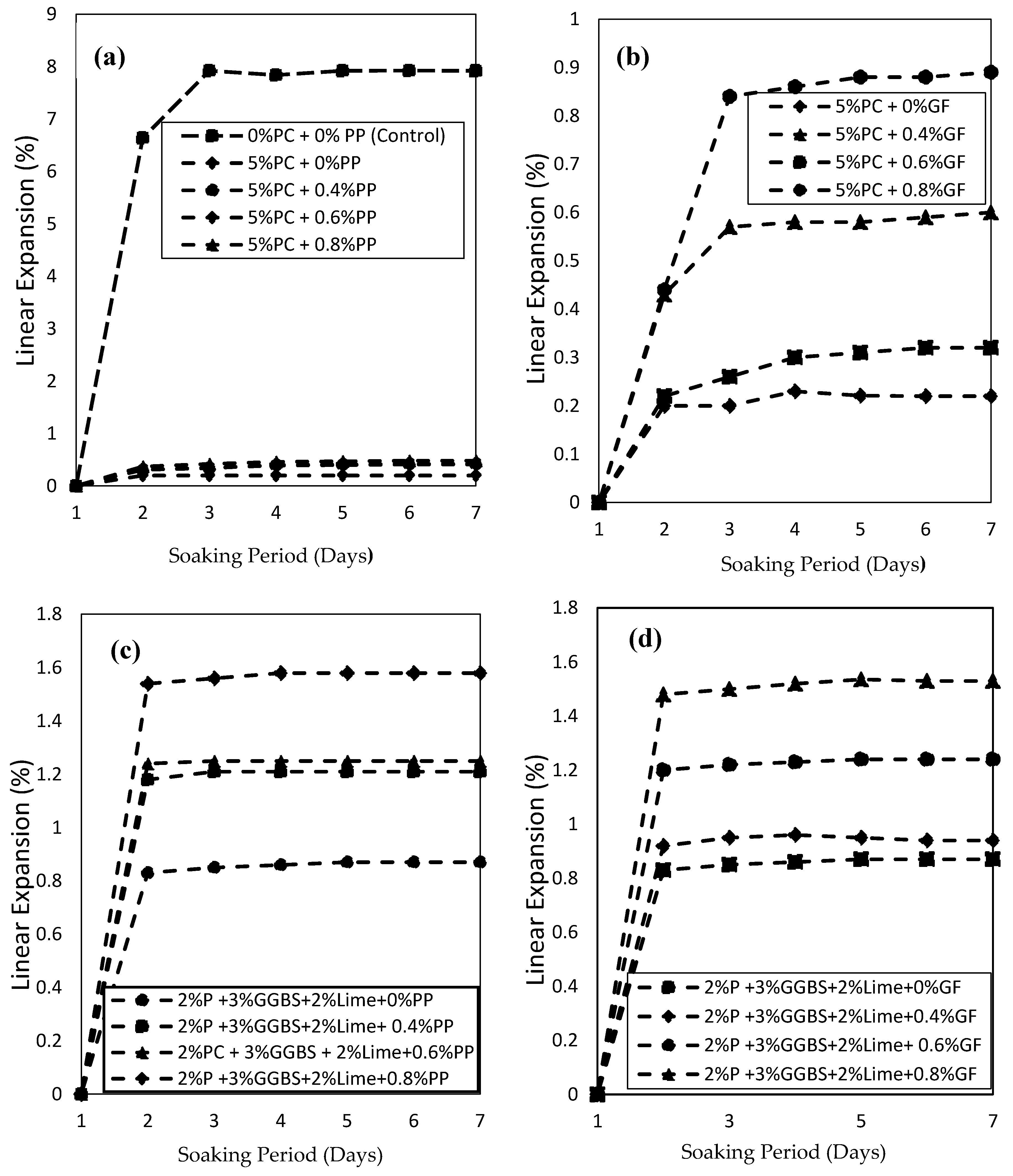
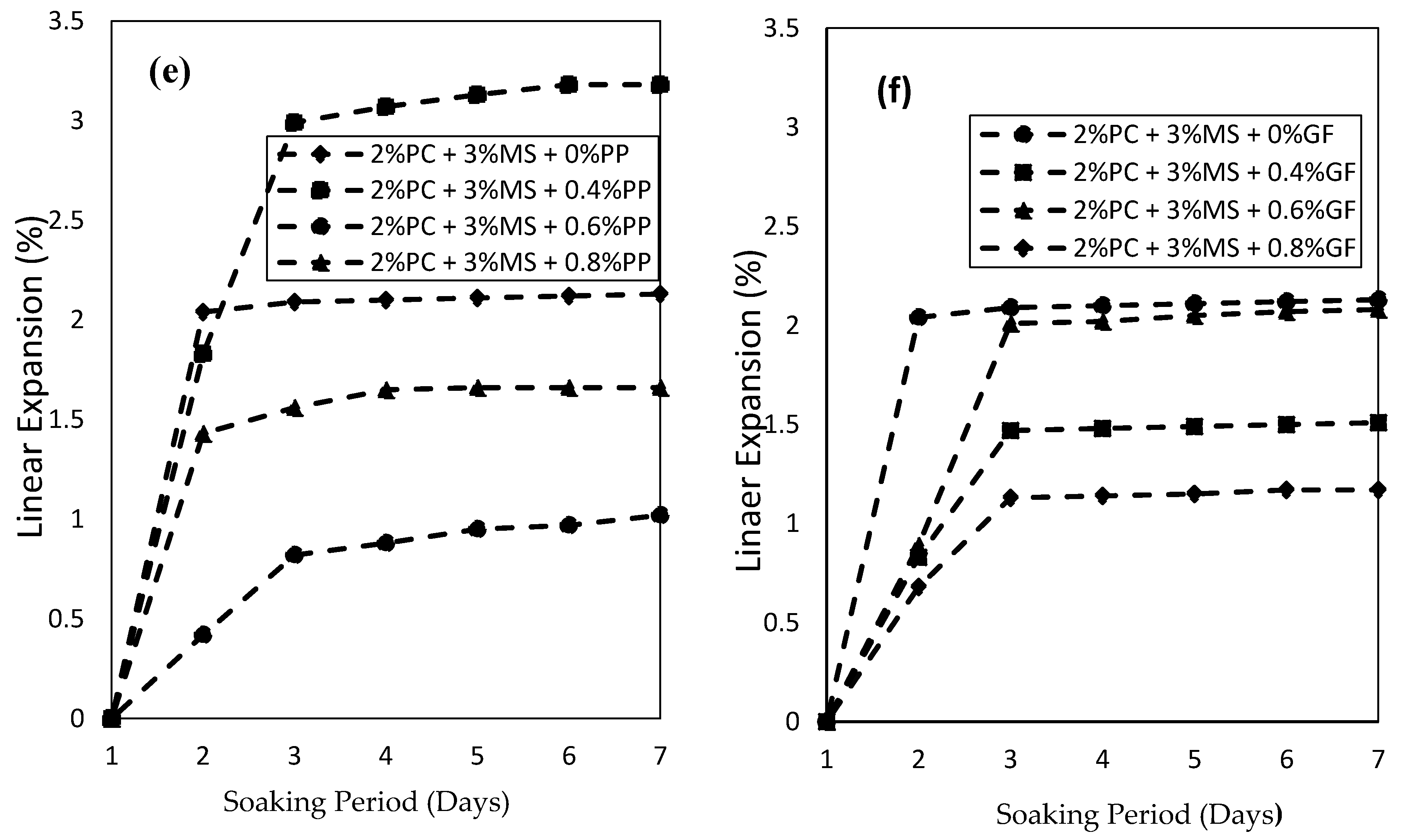
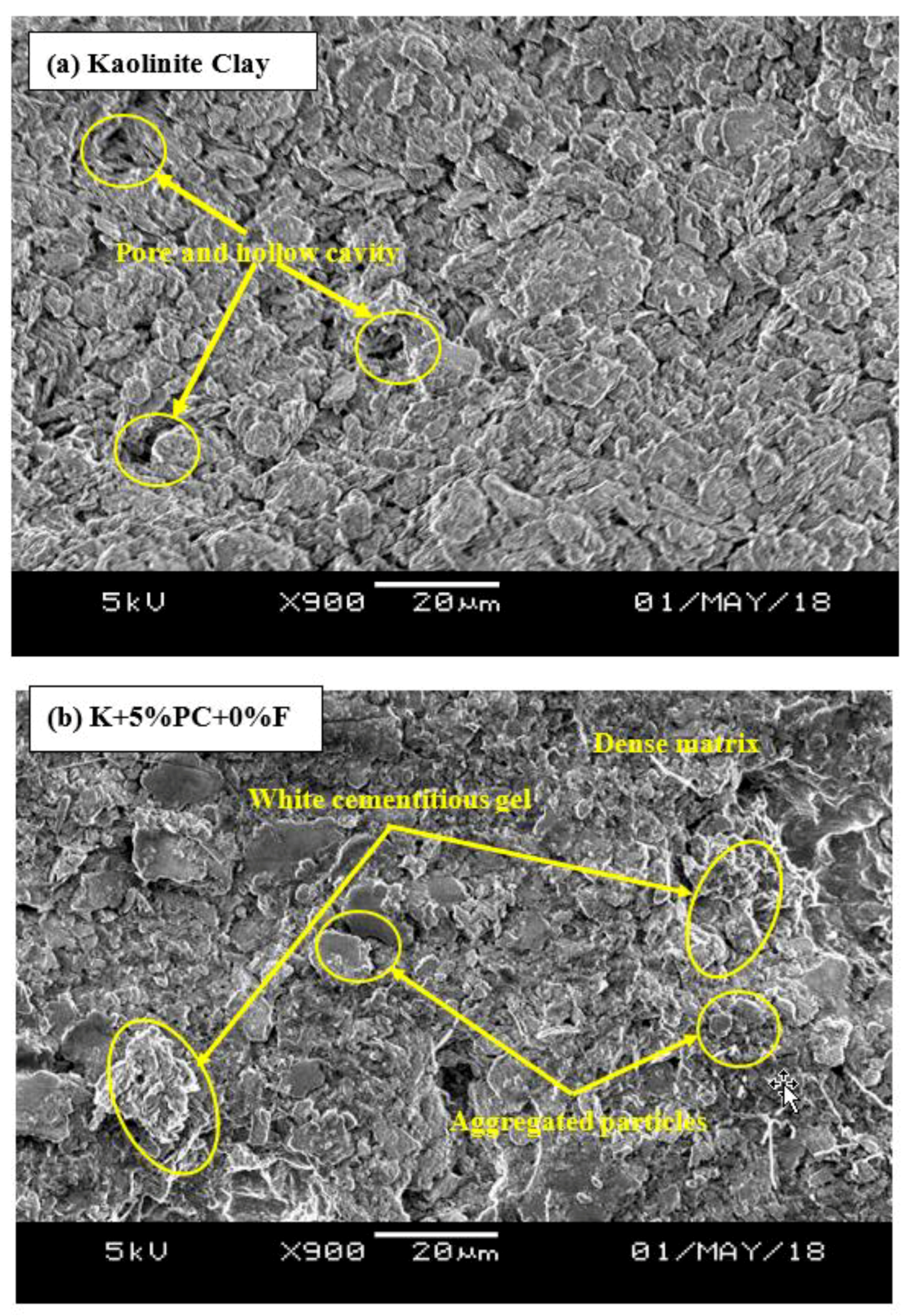
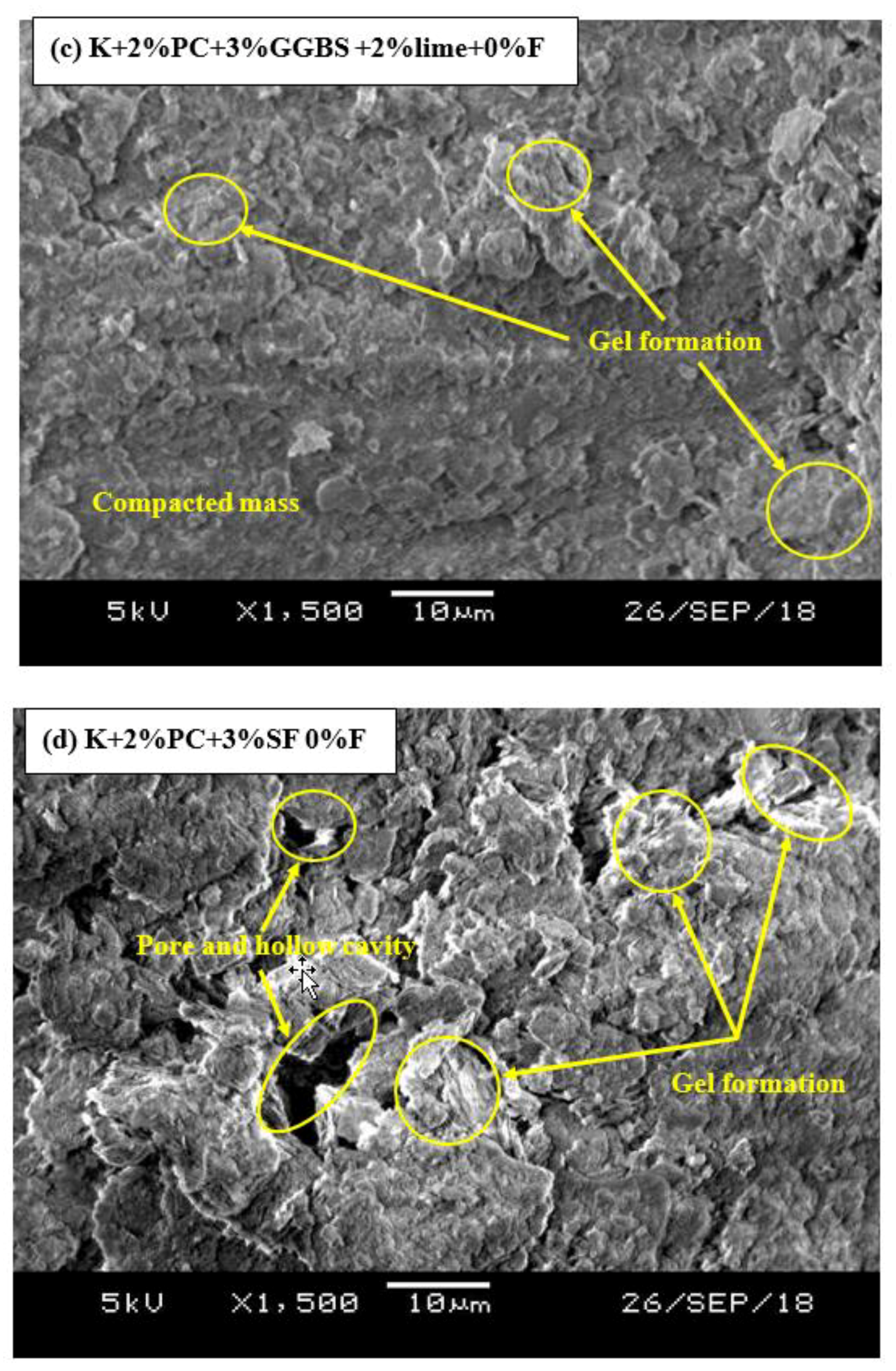
| Soil Property | Value |
|---|---|
| Consistency Limits | |
| Liquid limit wL (%) | 56 |
| Plastic limit wP(%) | 26 |
| Plasticity index Ip(%) | 30ZZ |
| Others | |
| Specific gravity | 2.6 |
| Expansion index, EI | 58.4 |
| Potential expansion | Medium |
| Maximum dry Density (kg/m3) | 1430 |
| timum moisture content (%) | 27 |
| Materials Used | Oxides (%) | |||||||||||
|---|---|---|---|---|---|---|---|---|---|---|---|---|
| SiO2 | TiO2 | Al2O3 | Fe2O3 | MnO | MgO | CaO | Na2O | K2O | P2O5 | SO3 | LOI | |
| Clay | 48.00 | 0.02 | 37.00 | 0.65 | - | 0.300 | 0.07 | - | 1.60 | - | - | 12.5 |
| Portland cement | 20.00 | - | 6.00 | 3.0 | 0.09 | 4.21 | 63.0 | - | - | 0.20 | 2.30 | 0.80 |
| GGBS | 33.28 | 0.57 | 13.12 | 0.32 | 0.316 | 7.74 | 37.16 | 0.33 | 0.474 | 0.009 | 2.21 | 4.42 |
| Micro silica | 90.6 | <0.1 | 1.47 | 1.93 | - | 0.42 | 1.52 | 0.63 | 1.31 | 0.28 | 0.41 | 1.33 |
| Mix Composition | Materials | Average OMC | ||||||
|---|---|---|---|---|---|---|---|---|
| Clay | Portland cement | Glass fibre | Polyprop-ylene fibre | Lime | GGBS | Micro silica | ||
| Untreated soil | ✓ | - | - | - | - | - | - | 28.2 |
| 5%PC + 0%F | ✓ | ✓ | - | - | - | - | - | 24.6 |
| 5%PC + 0.4%GF | ✓ | ✓ | ✓ | - | - | - | - | 24.4 |
| 5%PC + 0.4%PPF | ✓ | ✓ | - | ✓ | - | - | - | |
| 5%PC + 0.6%GF | ✓ | ✓ | ✓ | - | - | - | - | |
| 5%PC + 0.6%PPF | ✓ | ✓ | - | ✓ | - | - | - | |
| 5%PC + 0.8%GF | ✓ | ✓ | ✓ | - | - | - | - | |
| 5%PC + 0.8%PPF | ✓ | ✓ | - | ✓ | - | - | - | |
| 2%PC + 3%SCM + 2%Lime + 0%F | ✓ | ✓ | - | - | ✓ | ✓ | - | 24.4 |
| 2%PC + 3%SCM + 2%Lime + 0.4%GF | ✓ | ✓ | ✓ | - | ✓ | ✓ | - | 23.2 |
| 2%PC + 3%SCM + 2%Lime + 0.4%PPF | ✓ | ✓ | - | ✓ | ✓ | ✓ | - | |
| 2%PC + 3%SCM + 2%Lime + 0.6%GF | ✓ | ✓ | ✓ | - | ✓ | ✓ | - | |
| 2%PC + 3%SCM + 2%Lime + 0.6%PPF | ✓ | ✓ | - | ✓ | ✓ | ✓ | - | |
| 2%PC + 3%SCM + 2%Lime + 0.8%GF | ✓ | ✓ | ✓ | - | ✓ | ✓ | - | |
| 2%PC + 3%SCM + 2%Lime + 0.8%PPF | ✓ | ✓ | - | ✓ | ✓ | ✓ | - | |
| 2%PC + 3%SCM + 0%F | ✓ | ✓ | - | - | - | - | ✓ | 24.1 |
| 2%PC + 3%SCM + 0.4%GF | ✓ | ✓ | ✓ | - | - | - | ✓ | 23.5 |
| 2%PC + 3%SCM + 0.4%PPF | ✓ | ✓ | - | ✓ | - | - | ✓ | |
| 2%PC + 3%SCM + 0.6%GF | ✓ | ✓ | ✓ | - | - | - | ✓ | |
| 2%PC + 3%SCM + 0.6%PPF | ✓ | ✓ | - | ✓ | - | - | ✓ | |
| 2%PC + 3%SCM + 0.8%GF | ✓ | ✓ | ✓ | - | - | - | ✓ | |
| 2%PC + 3%SCM + 0.8%PPF | ✓ | ✓ | - | ✓ | - | - | ✓ | |
© 2020 by the authors. Licensee MDPI, Basel, Switzerland. This article is an open access article distributed under the terms and conditions of the Creative Commons Attribution (CC BY) license (http://creativecommons.org/licenses/by/4.0/).
Share and Cite
Abbey, S.J.; Eyo, E.U.; Oti, J.; Amakye, S.Y.; Ngambi, S. Mechanical Properties and Microstructure of Fibre-Reinforced Clay Blended with By-Product Cementitious Materials. Geosciences 2020, 10, 241. https://doi.org/10.3390/geosciences10060241
Abbey SJ, Eyo EU, Oti J, Amakye SY, Ngambi S. Mechanical Properties and Microstructure of Fibre-Reinforced Clay Blended with By-Product Cementitious Materials. Geosciences. 2020; 10(6):241. https://doi.org/10.3390/geosciences10060241
Chicago/Turabian StyleAbbey, Samuel J., Eyo U. Eyo, Jonathan Oti, Samuel Y. Amakye, and Samson Ngambi. 2020. "Mechanical Properties and Microstructure of Fibre-Reinforced Clay Blended with By-Product Cementitious Materials" Geosciences 10, no. 6: 241. https://doi.org/10.3390/geosciences10060241
APA StyleAbbey, S. J., Eyo, E. U., Oti, J., Amakye, S. Y., & Ngambi, S. (2020). Mechanical Properties and Microstructure of Fibre-Reinforced Clay Blended with By-Product Cementitious Materials. Geosciences, 10(6), 241. https://doi.org/10.3390/geosciences10060241








